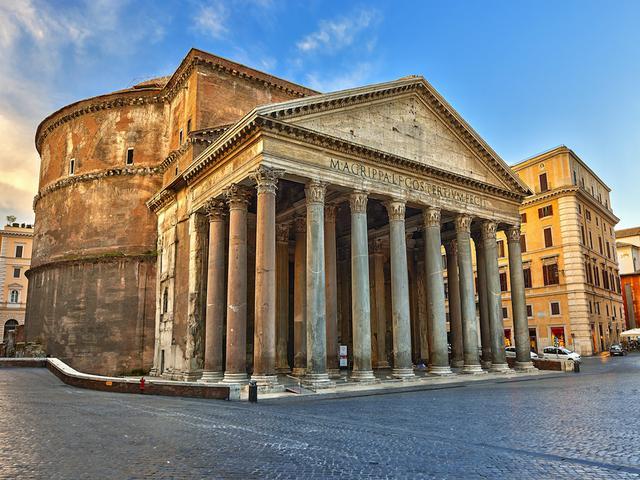Pantheon of Agrippa

The Pantheon of Agrippa, also known simply as the Pantheon, is a remarkable architectural marvel located in the heart of Rome, Italy. Originally built as an ancient Roman temple dedicated to all the gods of pagan Rome, it now serves as a church known as Santa Maria Rotonda. The history of the Pantheon dates back to the reign of Emperor Augustus, when Marcus Agrippa commissioned the construction of the original temple on the site. However, the current building that stands today was completed by Emperor Hadrian around 126 AD.
One of the most striking features of the Pantheon is its circular design, with a grand porch supported by large granite Corinthian columns. The entrance leads to a rectangular vestibule that connects to the rotunda, which is crowned by a magnificent coffered concrete dome. The most iconic element of the dome is the oculus, a central opening that allows natural light to filter into the space. This architectural feat is even more impressive considering that the dome is the largest unreinforced concrete dome in the world, a testament to the engineering prowess of the ancient Romans.
Visitors to the Pantheon are often awestruck by the sheer scale and beauty of the structure. The interior of the building is equally impressive, with intricate marble floors, ornate decorations, and stunning artwork adorning the walls. The Pantheon has stood the test of time, remaining remarkably well-preserved over the centuries. It has been in continuous use since the 7th century when it was consecrated as a Christian church, dedicated to "Saint Mary and the Martyrs."
Today, the Pantheon is a popular tourist destination, attracting millions of visitors each year who come to marvel at its architectural splendor and historical significance. The square in front of the Pantheon, known as Piazza della Rotonda, is a bustling hub of activity, with cafes, shops, and street performers adding to the vibrant atmosphere. The Pantheon is not just a monument to the past but a living testament to the enduring legacy of Roman civilization.
In addition to its architectural and historical significance, the Pantheon also plays a vital role in the cultural heritage of Italy. As a state property, it is under the care of the Italian Ministry of Cultural Heritage and Activities and Tourism. The Pantheon is part of the Polo Museale del Lazio, a network of museums and cultural institutions that preserve and promote Italy's rich artistic heritage. By visiting the Pantheon, tourists have the opportunity to immerse themselves in the history and culture of Rome, experiencing firsthand the grandeur of one of the world's most iconic architectural masterpieces.
© ChatGPT 3.5
After the Battle of Actium (31 BC), Marcus Agrippa began an impressive building programme: the Pantheon was a part of the complex created by him on his own property on the Campus Martius in 29-19 BC, which included three buildings aligned from south to north: the Baths of Agrippa, the Basilica of Neptune and the Pantheon. It seems likely that the Pantheon and the Basilica of Neptune were Agrippa's sacra privata, not aedes publicae (public temples). This less solemn designation would help explain how the building could have so easily lost its original name and purpose (Ziolkowski maintains that it was originally the Temple of Mars in Campo) in a relatively short period of time.
The building was originally approached by a flight of stairs. Later construction raised the ground level leading to the portico, eliminating these steps. The interior of the dome was possibly intended to symbolize the arched vault of the heavens. The oculus at the apex of the dome and the entrance door are the only natural sources of light inside. Throughout the day, light from the oculus moves around this space in a reverse sundial effect. The oculus also serves as a cooling and ventilation method. During storms, an underfloor drainage system handles rain that falls through the oculus.
Two kings of Italy are buried in the Pantheon: Vittorio Emanuele II and Umberto I, as well as Umberto’s Queen, Margherita.
The Pantheon is in use as a Catholic church. Masses are celebrated there on Sundays and holy days of obligation. Weddings are also held there from time to time.